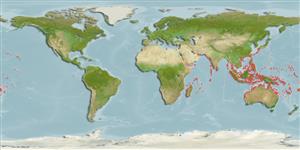Klassifizierung / Names
Namen | Synonyme | Catalog of Fishes (gen., sp.) | ITIS | CoL | WoRMS | Cloffa
Actinopterygii (Strahlenflosser) >
Beloniformes (Needle fishes) >
Hemiramphidae (Halfbeaks)
Etymology: Hemiramphus: Greek, hemi = half + Greek, rhamphos = bill, peak (Ref. 45335).
Lebensraum / Klimazone / Range
Ökologie
; seewasser; brackwasser riff-verbunden; standorttreu; tiefenbereich 0 - 6 m (Ref. 86942). Subtropical, preferred ?; 35°N - 36°S, 18°E - 159°W
Indo-West Pacific: Red Sea and East Africa to Samoa, north to the Ryukyu Islands, south to northern Australia and New Caledonia. Migrated to the eastern part of the Mediterranean Sea via the Suez Canal.
Length at first maturity / Size / Gewicht / Alter
Maturity: Lm ?, range 18 - ? cm
Max length : 45.0 cm TL Männchen/unbestimmt; (Ref. 30573); common length : 30.0 cm TL Männchen/unbestimmt; (Ref. 5450)
Rückenflossenstacheln (insgesamt): 0; Rückenflossenweichstrahlen (insgesamt): 12-15; Afterflossenstacheln 0; Afterflossenweichstrahlen: 10 - 12. Greatly prolonged, beak-like lower jaw; upper jaw short, triangular and without scales; preorbital ridge absent; total number of gill rakers on first gill arch 25-36; pectoral fins short, not reaching past nasal pit when folded forward; with 3-9 (usually 4-6) vertical bars on the sides. (Ref. 9843). Color bluish dorsally, silvery on sides. 36-41 predorsal scales. Lower lobe of caudal fin longer than upper lobe. Dorsal and anal fins located posteriorly.
Occur in coastal waters of high islands and continental shorelines; generally in areas rich in vegetation (Ref. 5213) and sand flats (Ref. 48635). Form schools. Adults feed mainly on sea grasses, to a lesser extent on green algae and diatoms (Ref. 9843). Breed in estuaries (Ref. 4164). Marketed fresh and dried salted (Ref. 5284, 9843); meat tasty (Ref. 637). Also caught with dragnets (Ref. 30573) and dipnets.
Life cycle and mating behavior
Geschlechtsreife | Fortpflanzung | Ablaichen | Eier | Fecundity | Larven
Collette, B.B. and J. Su, 1986. The halfbeaks (Pisces, Beloniformes, Hemiramphidae) of the Far East. Proc. Acad. Nat. Sci. Philadelphia 138(1):250-301. (Ref. 10943)
IUCN Rote Liste Status (Ref. 115185)
CITES (Ref. 94142)
Not Evaluated
Bedrohung für Menschen
Harmless
Nutzung durch Menschen
Fischereien: kommerziell; Sportfisch: ja; Köder: occasionally
Mehr Information
ReferenzenAquakulturAquakultur ProfilZuchtlinienGenetikAllel-HäufigkeitenVererbbarkeitKrankheitenVerarbeitungMass conversion
Tools
Zusatzinformationen
Download XML
Internet Quellen
Estimates of some properties based on models
Phylogenetic diversity index (Ref.
82805): PD
50 = 0.5005 [Uniqueness, from 0.5 = low to 2.0 = high].
Bayesian length-weight: a=0.00178 (0.00097 - 0.00326), b=3.19 (3.03 - 3.35), in cm Total Length, based on LWR estimates for this species & (Sub)family-body (Ref.
93245).
Trophic Level (Ref.
69278): 2.9 ±0.39 se; Based on food items.
Widerstandsfähigkeit (Ref.
69278): hoch, Verdopplung der Population dauert weniger als 15 Monate. (Preliminary K or Fecundity.).
Verwundbarkeit (Ref.
59153): Low to moderate vulnerability (26 of 100) .
